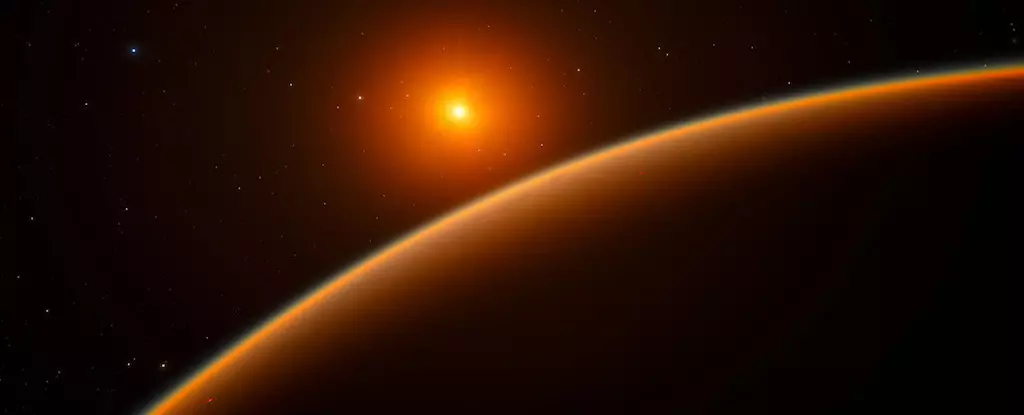Recent research has sent ripples of excitement throughout the astronomical community by suggesting that Earth-like exoplanets might be far more commonplace in the Milky Way than previously assumed. A team of astronomers, led by Weicheng Zang from the Harvard and Smithsonian Center for Astrophysics, has made a groundbreaking discovery: a super-Earth located in an orbital zone typically reserved for gas giants. The implications of such a finding ignite curiosity and challenge long-standing notions about the distribution and dynamics of planetary systems.
Super-Earths, defined as planets larger than Earth but smaller than Neptune, have historically been thought to reside primarily in close orbits around their stars. However, this new study unveils the possibility that these extraterrestrial worlds can also exist at greater distances, akin to the orbital ranges of our own Solar System’s gas giants, such as Jupiter and Saturn. This revelation could markedly expand our understanding of where life-sustaining conditions may arise beyond our planet.
Shattering Assumptions with Microlensing
The innovative approach adopted by Zang and his colleagues hinges on a phenomenon known as gravitational microlensing. This technique allows astronomers to observe the effects of gravity on light, akin to how a magnifying glass can amplify the brightness of small objects. By focusing on a specific microlensing event dubbed OGLE-2016-BLG-0007, the researchers tapped into the capabilities of the Korea Microlensing Telescope Network (KMTNet), which comprises observatories in Australia, Chile, and South Africa.
Microlensing events are notoriously rare, making the identification of planetary candidates through this method both a scientific challenge and an extraordinary opportunity. The study’s scope is impressive, encompassing three times the number of exoplanets in previous research efforts. This extensive dataset not only highlights the frequency of smaller exoplanets—an area that has been a focal point in exoplanet research—but also maps a diversity of planetary existence in the more remote reaches of stellar systems.
Ecosystems of Exoplanets: A Palette of Possibilities
The findings from this research point towards a staggering reality: approximately one in every three stars in our galaxy may host a super-Earth situated at a distance reminiscent of Jupiter’s orbit. This creates a more diverse picture of cosmic bodies than the traditional view has allowed. As co-author Andrew Gould emphasizes, it is not merely the survival of the biggest planets that matters; the cosmic population is marked by an elegant balance between various sizes and configurations of planets.
Such insights allow scientists to consider how different planetary types might exist alongside one another, thus hinting at the complex gravitational dynamics that shape their evolutionary paths. The implications go beyond academic curiosity; they evoke a deeper question about how we understand our own planet in the context of the universe. If super-Earths are indeed abundant at vast distances from their stars, the narrative of planetary formation will need revision. It will no longer suffocate under traditional viewpoints that favor only certain orbital ranges.
Challenges in Cosmic Exploration
Despite the exhilarating possibilities that the study presents, the journey toward further understanding remains fraught with obstacles. Co-author Richard Pogge notes that locating micro-lensing events is challenging enough, but finding a planet within those events is an exponentially complex task. This highlights the immense difficulty scientists face in revealing the nature of celestial bodies that orbit at wide distances from their stars.
The potential to redefine our perceptions is there; however, it is accompanied by the stark reality of the challenges inherent in deep-space observation. Advancements in technology and methods might soon ease these burdens, but until then, the astronomical community must remain patient and resourceful in their quest to unveil the myriad worlds silently orbiting distant suns.
Echoes of Planetary Diversity in Our Galaxy
The revelations stemming from Zang’s study indicate not only the presence of super-Earths but suggest avenues for understanding their formation and the overarching behaviors of planetary systems. Co-author Jennifer Yee speculates that the study marks a pivotal moment for recognizing diverse planetary conditions that may mimic or diverge from what we see within our own Solar System.
As the field of exoplanetary research continues to blossom, the conversation shifts from simply cataloging alien worlds to investigating the underlying principles that govern their existence. This change in paradigm sets the stage for a richer exploration of what it means to inhabit a planet, how life might flourish in varying environmental conditions, and ultimately, how unique or commonplace Earth truly is within the cosmic tapestry. The future of astronomy is buzzing with questions, discoveries, and an exhilarating potential to map our celestial neighborhood.


Leave a Reply